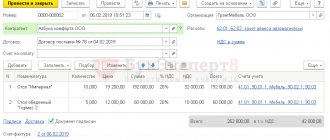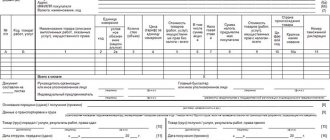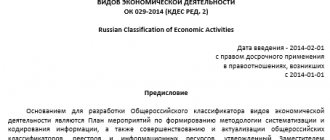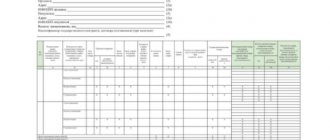What is it for and where to get the unit code
Indication of the unit of measurement code is required in column 2 of the main invoice table.
For each line, this code correlates with its letter designation given in the adjacent column 2a. In the specified units of measurement, column 3 shows the quantity of goods shipped (work performed, services), and column 4 shows the price of one unit. Accordingly, in column 5 (by multiplying the numbers contained in columns 3 and 4) the total cost of shipping one item is formed. The units of measurement may be different in different rows of the invoice table, but the principle of their use remains the same.
From 07/01/2021 a new invoice form is in effect, incl. adjustment, as amended by the Decree of the Government of the Russian Federation dated 04/02/2021 No. 534. The update of the form was caused by the introduction of a goods traceability system. All taxpayers are required to use the new form, even if the goods are not included in the traceability system. We described in more detail the changes made to the invoice here. And about the nuances of filling out new fields - here.
You can download the new invoice form by clicking on the image below:
ConsultantPlus experts have prepared step-by-step instructions for preparing each line of the updated invoice. To do everything correctly, get trial access to the system and go to the Guide. It's free.
Indication of the unit of measurement code indicates that the unit was taken from a directory approved at the state level. The purpose of creating such a classifier was to unify the units of measurement used in the Russian Federation. For the user, its presence provides a certain convenience and eliminates the need to come up with your own units. This reference book was approved by Decree of the State Standard of the Russian Federation dated December 26, 1995 No. 366 and is officially called “OK 015-94 (MK 002-97). All-Russian classifier of units of measurement."
Read about the rules for issuing invoices in the article “Resolution of the Government of the Russian Federation No. 1137: nuances of filling out VAT documents .
Unit code
In column 2 of the UPD table corresponding to the invoice, indicate the unit code. Column 2a shows the accepted symbol. In column 3 – amount (volume). Data on units of measurement are taken from the All-Russian Classifier of Units of Measurement OK 015-94 (MK 002-97) (approved by Gosstandart Resolution No. 366 of December 26, 1994).
For example, code 796 refers to the unit of measurement "piece" (denoted "pieces"), 006 - "meter" ("m"), 657 - "product" ("unit"), etc.
But what if the classifier does not contain the designation you need?
What to do if the unit of measurement is not in the classifier
If the unit of measurement used by the taxpayer is not in the reference book, then there are 3 possible ways:
- Try to choose a unit that fits the meaning. Most often, the one you are used to using is successfully replaced with a piece (code 796).
- Do not indicate the unit at all by putting a dash in columns 2, 2a and 3. This is allowed by subsection. “b” and “c” clause 2 of section 2 of appendix 1 to Decree of the Government of the Russian Federation dated December 26, 2011 No. 1137 (see also letter of the Ministry of Finance of the Russian Federation dated February 10, 2012 No. 03-07-09/06).
- Specify your own unit.
How services are measured
There is no service unit code in the unit of measurement classifier. For this reason, when providing services, many write down code 796, which refers to spare parts. And a service is an activity whose results do not have material expression (clause 5 of Article 38 of the Tax Code of the Russian Federation). Therefore, services are not measured in pieces.
At the same time, the UPD form serves, among other things, as the basis for clients of the service to accept VAT amounts for deduction. Therefore, the UPD must indicate the quantity (volume) and unit of measurement of what is being sold, as well as the price (rate) per unit of measurement (subclause 6, clause 5, article 169 of the Tax Code of the Russian Federation). But only if there is an opportunity for this.
If this is not possible, hyphens must be entered in the “unit of measurement” and “quantity” columns (point “b” of paragraph 2 of the Rules for filling out an invoice, approved by Resolution No. 1137). The Ministry of Finance has repeatedly pointed this out (see, for example, letter dated 06/05/2015 No. 03-07-09/32579, etc.). The courts agree (see, for example, the decision of the Arbitration Court of the North Caucasus District dated March 18, 2016 No. F08-1159/2016). And the price (tariff) per unit of measurement is the price of the service provided according to the price list.
Therefore, there is no need to guess. If goods (work, services) sold are measured in units not specified in the Classifier of Units of Measurement, a hyphen is entered in the corresponding columns of the invoice or UPD.
How is the service assessed upon shipment?
A service or work can most often be priced in units. For example:
- the same type of repair of several products can be assessed by the number of these products;
- the work performed ultimately has some result that can be assessed quantitatively;
- the provision of rent of even several units under one contract can be considered one unit per month, provided that the number of objects leased remains unchanged;
- also, the number of services may correspond to the number of objects provided for rent, provided they are of the same cost.
If it is difficult to estimate the quantity of the service provided, you can take the opportunity not to indicate a unit for it at all by putting dashes in columns 2, 2a, 3, and in columns 4 and 5 - its price and total cost.
Service code on the invoice
If everything is clear regarding units of measurement of weight, length, area, then what to do when it comes to services?
In relation to works and services, the relevant information in these columns 2 “Code” and 2a “Symbol” is filled in if it is possible to indicate them. That is, the code in the invoice must be indicated if the services provided can be measured at all and, accordingly, the unit of measurement can be selected, as well as the corresponding code can be found in the classifier.
For example, the price for construction work can be indicated per square meter. Then in the invoice in columns 2 and 2a you need to indicate the service code in the invoice “055” and the symbol “m2”, respectively. How to measure, for example, consulting services? In this case, when issuing an invoice for these services, dashes are placed in columns 2, 2a, as well as column 3 – “Quantity (volume)” and column 4 – “Price (tariff) per unit of measurement”.
The service code is sometimes confused with the transaction type code.
The transaction type code in the invoice is used to maintain a journal of invoices that have been received and issued, purchase ledgers and sales ledgers. Read more about transaction type codes here. You can find more complete information on the topic in ConsultantPlus. Free trial access to the system for 2 days.
Consequences of an error in specifying the unit of measurement
Errors in indicating the unit of measurement and its code in the invoice do not entail negative consequences in relation to the acceptance of VAT for deduction. This is confirmed by letters of the Ministry of Finance of the Russian Federation dated 09/08/2014 No. 03-07-09/44915 and dated 08/26/2014 No. 03-07-09/42594.
Read about the consequences of other errors in the invoice in the articles “If the checkpoint is incorrectly indicated on the invoice” and “Invoice: reduction can be dangerous for deductions” .
An error in specifying the unit of measurement will not affect the deduction
If the unit of measurement code is indicated incorrectly in the invoice, for example, when specifying services, the contractor indicated pcs. instead of a hyphen, this will not affect the customer's VAT deduction. This error is not critical. And the critical errors for which deductions will be denied are those that do not allow one to determine (clause 2 of Article 169 of the Tax Code of the Russian Federation):
- seller;
- buyer;
- name of goods (works, services);
- cost of goods (works, services);
- VAT rate;
- the amount of tax charged to the buyer.
Results
Units of measurement in the invoice, as a rule, are indicated in accordance with the All-Russian Classifier of Units of Measurement.
And if there is no unit of measurement in the classifier, it is possible to indicate in the invoice either a unit that is suitable in meaning, or your own. In the case of rendering services or performing work, a dash may be entered in columns 2 and 2a instead of the unit code and name of the unit. You can find more complete information on the topic in ConsultantPlus. Free trial access to the system for 2 days.
Invoice unit code
When filling out the details, pay attention to the “unit of measurement code” column. Let's figure out what to enter there.
The main part of the document contains a table of 8 columns. In the first column you must fill in the name of the product or service that was provided, then you must indicate the code of the type of product. The next column contains information about the unit of measurement. The column is divided into two parts: “unit code” and “symbol”.
What code needs to be filled in this column? The unit of measurement code in the invoice is filled out in accordance with sections 1 and 2 of the All-Russian Classifier of Units of Measurement (OKEI). The code consists of three digits. For example, a kilogram has the code 166 and the national symbol “kg”, and a ton has the code “168” and the national symbol “t”.
If the indicators that you need to indicate are not in the classifier, then it is not possible to fill them out. In this case, dashes are entered in columns 2, 2a, 3.
How does the customer calculate the price?
Here's how to calculate the cost of a tender for procurement with a price per unit of GWS:
Step 1. Determine the NMCC units of GWS based on the provisions of Art. 22 44-FZ and methodological recommendations from the order of the Ministry of Economic Development No. 567 dated 10/02/2013. according to the formula:
When calculating the NMCC state order for the purchase of medicines, they are guided by the methodology from the order of the Ministry of Health No. 1064n dated December 19, 2019, and when purchasing medical products - by the rules from the order of the Ministry of Health dated May 15, 2020 No. 450n.
More details:
- “Instructions for the purchase of medicines under 44-FZ in 2022”;
- “Instructions for the purchase of medical equipment and medical products.”
Step 2. Calculate the sum of prices of GWS units, which is equal to the NMCP of all items in the purchase using the formula:
Here is an example of determining the sum of prices of units of goods from government procurement:
Step 3. Determine the order limit. This value depends on the customer's financing. A situation is acceptable when funding exceeds the total tender amount or is below this value. Example: a government order for the provision of laboratory research services was placed for 68,185.00 rubles, and the amount of financing for the purchase is 500,000.00 rubles. In this case, the total cost is less than the financial support, since when calculating the customer took the value per unit. services. Financing will allow you to choose a larger number of them during the provision of services.
An example of such a notice from the Unified Information System:
Which classifier should you use to look for information?
Units of measurement codes for invoices must be filled out based on the All-Russian Classifier of Units of Measurement (OKEY). It was approved by Decree of the State Standard of Russia dated December 26, 1994 No. 366. The classifier was developed on the basis of the international classification. Units of measurement in OKEI are divided into seven groups:
- length;
- square;
- volume;
- weight;
- technical;
- time;
- economic.
The information is presented in table form:
To fill out columns 2 and 2a of the invoice, information about the code of the unit of measurement and its national symbol is required. To understand what the code on the invoice means, you can contact OKEI and find the name using the coded designation.
When you don’t need to fill out the details
In some cases, columns 2 and 2a will remain blank. In this case, dashes are added to them. You do not need to complete these sections of the invoice if:
- the invoice is issued for prepayment (clause 4 of the Rules for filling);
- the contract indicates the total cost of work or services and there is no breakdown of the price per piece, kilogram, individual type of work, etc.;
- the contract specifies the name of the quantitative characteristics of the product, work or service, which are not in sections 1 and 2 of the OKEI;
- a product, work or service does not have a unit of measurement.
For example, when issuing documents, the lessor does not indicate the service code in the invoice (Letter of the Ministry of Finance dated February 10, 2012 No. 03-07-09/06).







